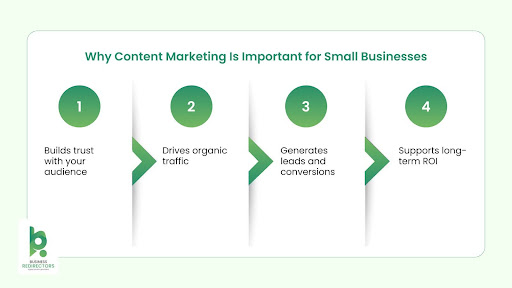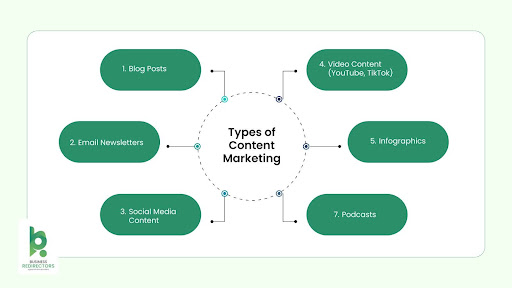- Introduction: The New Age of Content Marketing
- Why Content Marketing Is Important for Small Businesses
- Content Marketing Strategies for Small Business Success in 2025
- 1. Define Your Target Audience Clearly
- 2. Set SMART Goals for Your Content Marketing
- 3. Content Marketing Strategy Examples That Work
- 4. Types of Content Marketing Small Businesses Should Use
- 5. Create and Use a Content Calendar
- 6. Leverage SEO to Maximize Reach
- 7. Promote Your Content Across the Right Channels
- 8. Measure What Matters
- 9. Embrace AI and Automation in Your Content Workflow
- 10. Diversify Your Content to Match Audience Preferences
- Conclusion:
- FAQs
Introduction: The New Age of Content Marketing
In 2025, content marketing for small business has transformed from a trend to a necessity. With customer behavior changing and digital platforms evolving, small businesses can no longer rely on outdated advertising techniques. Instead, they must focus on creating and sharing valuable, relevant, and consistent content that builds trust, drives organic traffic, and fuels growth.
In this ultimate guide, we’ll walk you through the most important content marketing strategies tailored for small businesses in 2025. Whether you’re just starting out or refining your digital approach, this comprehensive guide will help you compete effectively—even against the big players.
Why Content Marketing Is Important for Small Businesses

In today’s competitive digital landscape, content is more than just words on a page—it’s a business asset.
Here’s why content marketing is important for small businesses in 2025:
- Builds trust with your audience: Consistent, high-quality content positions your business as an authority.
- Drives organic traffic: Optimized content helps your website rank higher on search engines.
- Generates leads and conversions: Content like lead magnets and email sequences can nurture cold traffic into loyal customers.
- Supports long-term ROI: Unlike paid ads, good content keeps bringing value over time.
If you’re a small business with limited marketing budget, content marketing gives you a scalable and cost-effective way to compete.
Content Marketing Strategies for Small Business Success in 2025
Let’s explore the top content marketing strategies for small business owners looking to grow in 2025.
1. Define Your Target Audience Clearly
Without knowing who you’re talking to, your message will miss the mark. Use surveys, Google Analytics, or social media insights to build a detailed customer persona. Understand their:
- Demographics
- Pain points
- Buying behavior
- Preferred platforms
When you know your audience, your content will resonate deeper and convert better.
2. Set SMART Goals for Your Content Marketing

Align your content marketing with clear business objectives. Your goals should be:
- Specific
The goal clearly defines what you want to achieve without ambiguity.
- Measurable
Progress can be tracked with numbers or metrics.
- Achievable
The goal should be realistic based on available resources and time.
- Relevant
The goal must align with your overall business objectives.
- Time-bound
Every goal must have a clear deadline to stay on track.
Example goals:
- Increase blog traffic by 40% in 6 months
- Generate 200 qualified leads per month
- Boost email click-through rate by 15%
3. Content Marketing Strategy Examples That Work

Here are some real-world content marketing strategy examples you can apply in 2025:
- B2B Example: A SaaS startup publishes weekly LinkedIn articles answering FAQs of business owners and links back to gated lead magnets.
- Local Business Example: A bakery shares behind-the-scenes videos on Instagram Reels, paired with blog posts on recipe stories.
- Ecommerce Brand: Posts YouTube “how-to” videos for product use, optimized for SEO, and uses blog posts to support ranking.
These strategies build authority, engagement, and sales.
4. Types of Content Marketing Small Businesses Should Use

To stand out in 2025, embrace a variety of formats. Here are the top types of content marketing to try:
- Blog Posts: Great for SEO and education
- Email Newsletters: Ideal for nurturing leads
- Social Media Content: Builds community and brand voice
- Video Content (YouTube, TikTok): High engagement
- Infographics: Easy to digest and share
- Podcasts: Perfect for thought leadership
Diversifying content keeps your brand relevant and accessible.
5. Create and Use a Content Calendar
Planning ahead is crucial for consistency. A content calendar helps you:
- Avoid last-minute rush
- Stay on top of trends
- Maintain a healthy posting frequency
Use tools like Trello, Notion, or Google Calendar to manage your schedule efficiently.
6. Leverage SEO to Maximize Reach
SEO isn’t just for large corporations. Small businesses must optimize every piece of content for search.
- Use AI tools like SurferSEO, Ubersuggest, or Semrush to find keywords
- Optimize for mobile
- Write for humans first, algorithms second
- Add internal links and fast-loading pages
Ranking well = consistent traffic = more sales.
7. Promote Your Content Across the Right Channels
Don’t just publish—promote. Use:
- Email marketing: Nurture with valuable content
- Social sharing: Create native content per platform
- Paid ads: Boost top-performing posts
- Collaborations: Guest posts, influencer mentions, or partnerships
Find where your audience hangs out—and show up there.
8. Measure What Matters
You can’t improve what you don’t measure. Track performance using:
- Google Analytics (traffic, bounce rate, conversions)
- SEMrush (keyword positions, backlinks)
- Hotjar (user behavior insights)
Use the data to test new content types or pivot your strategy.
9. Embrace AI and Automation in Your Content Workflow
In 2025, AI is your teammate.
- Content Research: ChatGPT, Jasper
- Content Editing: Grammarly, Hemingway
- Automation: Buffer, Zapier, HubSpot for email sequences
Save time on repetitive tasks and focus more on strategy and creativity.
10. Diversify Your Content to Match Audience Preferences
Today’s audiences consume content in many ways. Go beyond text:
- Short-form video (Reels, Shorts)
- Interactive quizzes
- Webinars or live Q&As
- AI-powered personalized content
The more diverse your content, the broader your reach.
Conclusion:
Content marketing for small business isn’t optional in 2025—it’s the backbone of digital success. By defining your audience, creating valuable content, leveraging SEO, and tracking your results, you can grow sustainably even with a limited budget.
Looking to scale faster? Check out our guide on Business Redirectors to discover how smart strategies can amplify your growth in 2025.
Start small, stay consistent, and let your content become your best salesperson.
FAQs
Q1: What is the future of content marketing in 2025?
Answer: Content marketing will become more personalized, AI-driven, and video-centric. Small businesses will rely on data insights and automation to streamline campaigns and improve targeting.
Q2: What are the marketing strategy trends for 2025?
Answer: Key trends include AI content generation, hyper-personalization, voice search optimization, short-form video dominance, and integration of augmented reality (AR) in content experiences.
What will happen to small businesses in 2025?
Answer: Small businesses will face increasing competition but greater access to global markets. Those who adopt digital tools, including strong content marketing strategies, will thrive and grow rapidly.
Q4: Is digital marketing still worth it in 2025?
Answer: Absolutely. Digital marketing remains one of the most cost-effective ways for small businesses to build brand awareness, drive traffic, and generate leads. It’s evolving but far from obsolete.
Q5: How can small businesses create content consistently without a big team?
Answer: Use AI tools for content ideas, templates, and scheduling. Outsource where necessary, repurpose old content, and use automation platforms to stay consistent without hiring a full-time team.
